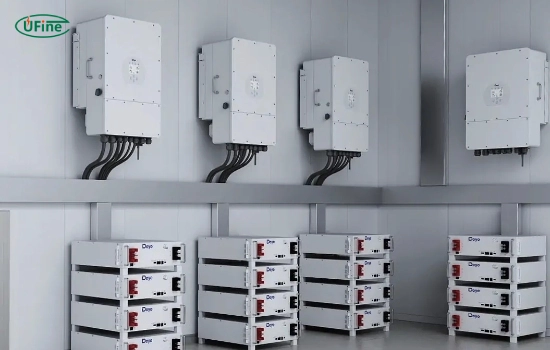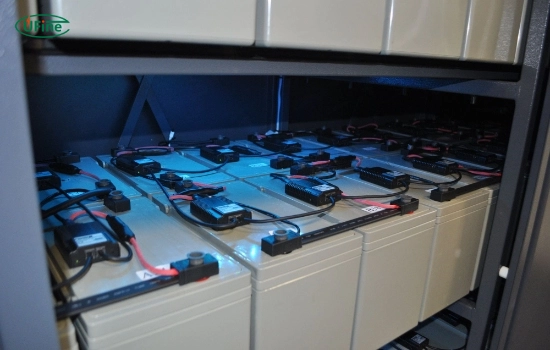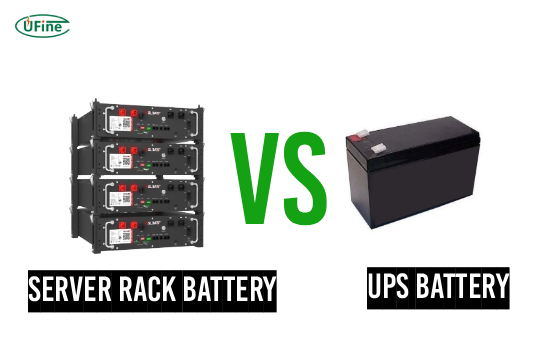
- Part 1. What is a server rack battery?
- Part 2. What is a UPS battery?
- Part 3. Server rack battery vs UPS battery: Key differences
- Part 4. Why are data centers switching to rack battery systems?
- Part 5. Real-world example: Data center battery upgrade
- Part 6. Installation flexibility: Rack battery vs UPS
- Part 7. Server rack battery vs UPS battery: Maintenance and monitoring
- Part 8. Server rack battery vs UPS battery: Cost comparison over time
- Part 9. Server rack battery vs UPS battery: Safety and environmental impact
- Part 10. Server rack battery vs UPS battery: Who should switch to rack battery systems?
- Part 11. FAQs about server rack battery vs UPS battery
What’s the difference between a server rack battery and a UPS battery? The key difference lies in design, chemistry, and application. A server rack battery is typically a lithium-based energy storage system built for high-density installations, while a UPS battery often refers to traditional lead-acid batteries used in uninterruptible power supplies. When comparing server rack battery vs UPS, businesses must understand how these technologies impact performance, space, maintenance, and costs.
In this guide, we’ll break down the UPS battery difference, dive deep into the benefits of the rack battery system, and explain why many data centers are making the switch to lithium server rack batteries. If you’re considering an upgrade to your power backup system, read on.
Part 1. What is a server rack battery?
A server rack battery is a modular, high-density lithium battery system designed to fit within standard 19-inch or 23-inch server cabinets. These batteries are often based on LiFePO₄ (lithium iron phosphate) chemistry, known for safety, long life, and high energy efficiency.
They are built for scalability and are commonly used in:
- Data centers
- Telecom base stations
- Edge computing environments
- Industrial energy storage systems
Unlike traditional batteries, these rack batteries are built for integration, controlled through battery management systems (BMS), and monitored via software.
Part 2. What is a UPS battery?
A UPS battery (Uninterruptible Power Supply) is a power backup system that provides emergency electricity when the main power fails. Most UPS systems use sealed lead-acid (SLA) batteries, including VRLA (valve-regulated lead-acid) or AGM (absorbed glass mat) types.
These batteries are:
- Reliable for short-term power
- Cost-effective initially
- Widely used in office and IT environments
However, they are heavy, bulky, and require frequent maintenance. Their lifespan is also limited compared to lithium alternatives.
Part 3. Server rack battery vs UPS battery: Key differences
Here’s a detailed comparison between UPS lead-acid batteries and lithium server rack batteries:
| Feature | UPS Lead-Acid Battery | Server Rack Lithium Battery |
|---|---|---|
| Chemistry | Lead-Acid (VRLA/AGM) | Lithium Iron Phosphate (LiFePO₄) |
| Lifespan | 3–5 years | 10–15 years |
| Cycle Life | ~300–500 cycles | 3000+ cycles |
| Energy Density | Low | High |
| Maintenance | High (regular checks needed) | Low (intelligent monitoring) |
| Weight | Heavy | Lightweight |
| Installation Flexibility | Limited (floor-mounted) | High (rack-mounted/modular) |
| Footprint | Large | Compact |
| Monitoring | Basic | Advanced (BMS, software integration) |
| Cost (Initial) | Low | Higher |
| Cost (Lifetime) | Higher (due to replacement/maintenance) | Lower (longer life, low maintenance) |
This table clearly shows why lithium rack battery systems are becoming the preferred choice for modern infrastructure.
Part 4. Why are data centers switching to rack battery systems?
Data centers require high uptime, reliability, and scalable power backup. Traditional UPS batteries can’t keep up with the rapid growth in data demand. Here’s why lithium rack battery systems are taking over:
- Space-saving design
Rack batteries fit directly into server cabinets, saving valuable floor space. - Longer lifespan
With up to 10–15 years of life, lithium batteries drastically reduce the need for replacements. - Low maintenance
Smart BMS systems provide real-time monitoring, reducing manual checks and maintenance costs. - Scalability
You can add more battery modules as your power demand grows. This is perfect for modular data centers. - Faster charging
Lithium batteries charge faster and more efficiently. This reduces downtime after power outages.
Part 5. Real-world example: Data center battery upgrade
Case Study: Mid-sized data center in Singapore
A data center in Singapore replaced its aging lead-acid UPS system with a 48V 100Ah lithium rack battery system. The results were immediate:
- Reduced battery room size by 40%
- Cut maintenance labor by 60%
- Extended battery replacement cycle from 4 to 12 years
- Improved energy efficiency by 15%
This upgrade not only improved uptime but also reduced operational costs.
Part 6. Installation flexibility: Rack battery vs UPS
Installing a traditional UPS system often means dedicated battery rooms, heavy lifting, and complex wiring.
In contrast, rack battery systems offer:
- Plug-and-play modularity
- Standard-size compatibility
- Easy front-access maintenance
- Vertical or horizontal stacking
This makes them ideal for edge computing, co-location facilities, and mobile data centers.
Part 7. Server rack battery vs UPS battery: Maintenance and monitoring
UPS lead-acid batteries require periodic:
- Voltage checks
- Equalization charging
- Temperature controls
- Manual inspection
Rack lithium batteries come with BMS that handle:
- Voltage balancing
- Overcharge/undervoltage protection
- Temperature regulation
- Remote diagnostics
This saves time, reduces risk, and improves reliability.
Part 8. Server rack battery vs UPS battery: Cost comparison over time
While initial investment in lithium rack batteries is higher, the total cost of ownership (TCO) is much lower.
Example comparison over 10 years (for 100kWh system):
| Cost Component | Lead-Acid UPS | Lithium Rack Battery |
|---|---|---|
| Initial Cost | $10,000 | $18,000 |
| Replacement (every 4 years) | $20,000 | $0 |
| Maintenance | $5,000 | $1,000 |
| Energy Losses | Higher | Lower |
| Total (10 years) | $35,000 | $19,000 |
Over time, lithium rack systems are clearly more economical.
Part 9. Server rack battery vs UPS battery: Safety and environmental impact
Lithium rack batteries are safer than ever due to:
- Integrated BMS
- Thermal management
- Fire retardant casings
They are also eco-friendlier, with recyclable materials and no harmful gas emissions.
Lead-acid batteries, on the other hand, are toxic, heavy, and more prone to thermal runaway.
Part 10. Server rack battery vs UPS battery: Who should switch to rack battery systems?
If your business:
- Runs a data center
- Manages large-scale IT infrastructure
- Is planning to scale operations
- Wants to reduce energy costs
- Needs reliable backup with minimal downtime
Then it’s time to consider switching to a rack battery system. The ROI is clear.
Part 11. FAQs about server rack battery vs UPS battery
What is the main difference between a server rack battery and a UPS battery?
The main difference is that a server rack battery uses lithium technology, is modular, and designed for high-density IT environments, while a traditional UPS battery uses lead-acid, is bulky, and has a shorter lifespan.
Are lithium rack batteries safer than lead-acid UPS batteries?
Yes. Lithium rack batteries come with built-in safety features like BMS and thermal monitoring, making them safer and more reliable than lead-acid systems.
Can I retrofit my existing UPS system with a rack battery?
In many cases, yes. However, it depends on your inverter compatibility, voltage requirements, and battery management system integration. Consulting with a battery expert is recommended.
How long do server rack batteries last?
Most lithium rack batteries last 10 to 15 years with over 3000 cycles, compared to 3–5 years for lead-acid UPS batteries.
Is a rack battery system worth the initial investment?
Absolutely. While the upfront cost is higher, the longer life, lower maintenance, and space savings lead to significantly lower total costs over time.
Related Tags:
More Articles

Why Lithium Batteries Don’t Rust: Chemical Stability Explained
Learn why lithium batteries don’t rust. Their iron-free chemistry and moisture protection make them more corrosion-resistant than lead-acid or alkaline types.
How to Choose the Right Server Rack Battery for Your Data Center?
Find out how to choose the right server rack battery for your data center. Consider capacity, runtime, safety, and compatibility for reliable backup power.
What Is a Server Rack Battery? A Complete Guide for Data Centers and IT
Discover what a server rack battery is, how it works, and why it’s essential for reliable data center and IT power backup. Learn key features and benefits.
Understanding the Difference Between AA and AAA Batteries
Wondering about the difference between AA and AAA batteries? Learn the key differences, similarities, and when to use each in this detailed guide.
3S LiPo Batteries Explained – How to Pick the Best 3S Battery
This guide includes 3S voltage charts, capacity options, life, safety rules, and top recommended batteries — so you can choose the best 3S LiPo battery.





